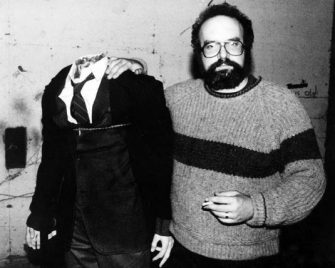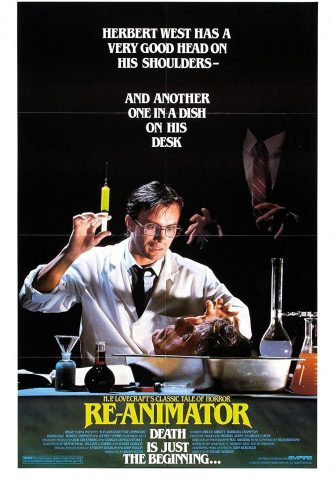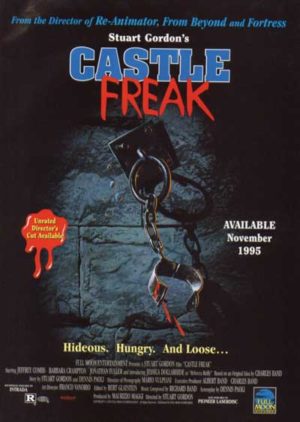 You may not know the name Stuart Gordon, but the chances are good that if you’re a fan of post-1980 horror cinema then you’re a Stuart Gordon fan. Very few other filmmakers enjoyed such a consistently vital and unpredictable career in the field—a career that produced one masterpiece, several almost-great follow-ups and a number of misfires. Yes, Gordon turned out some clunkers in his day, which is to be expected from any prolific filmmaker working in any genre, but his talent was such that he was always able to bounce back from those failures.
You may not know the name Stuart Gordon, but the chances are good that if you’re a fan of post-1980 horror cinema then you’re a Stuart Gordon fan. Very few other filmmakers enjoyed such a consistently vital and unpredictable career in the field—a career that produced one masterpiece, several almost-great follow-ups and a number of misfires. Yes, Gordon turned out some clunkers in his day, which is to be expected from any prolific filmmaker working in any genre, but his talent was such that he was always able to bounce back from those failures.
…if you’re a fan of post-1980 horror cinema then you’re a Stuart Gordon fan.
 Stuart Gordon got his start, together with his longtime spouse Carolyn Purdy-Gordon (who would be featured, and killed, in many of his films), in the Chicago theater scene, as founder of the Organic Theater. Among other milestones, he directed the Chicago premiere of David Mamet’s iconic “Sexual Perversity in Chicago.” Mamet for his part has described Gordon’s revolutionary-for-its-era approach thusly: “Stuart’s notion was that anything which could be done on film could be done on the stage, so he created, play-by-play, a stagecraft of effect: blood, gore, nudity, music, sound, and so on.”
Stuart Gordon got his start, together with his longtime spouse Carolyn Purdy-Gordon (who would be featured, and killed, in many of his films), in the Chicago theater scene, as founder of the Organic Theater. Among other milestones, he directed the Chicago premiere of David Mamet’s iconic “Sexual Perversity in Chicago.” Mamet for his part has described Gordon’s revolutionary-for-its-era approach thusly: “Stuart’s notion was that anything which could be done on film could be done on the stage, so he created, play-by-play, a stagecraft of effect: blood, gore, nudity, music, sound, and so on.”
 With that in mind it’s hardly a surprise that Gordon’s debut film, 1985’s RE-ANIMATOR, was such an impressive piece of filmmaking. Unlike many theater mavens that turn to filmmaking, who tend to have trouble with things like thematic consistency and mechanics of film grammar (see Mamet’s own self-directed films for proof), Gordon evinced a confident and assured directorial hand. His theatrical training was evident in the strong performances he elicited from his cast (Jeffrey Combs, Barbara Crampton, Bruce Abbott and David Gale have never been as strong onscreen as they were in RE-ANIMATOR and subsequent Gordon films), as was an unapologetic love of gore, viscera and B-movie horror trappings. Indeed, one of RE-ANIMATOR’S primary attributes is that it, despite being far above average in the category of low budget horror cinema, clearly knows its place.
With that in mind it’s hardly a surprise that Gordon’s debut film, 1985’s RE-ANIMATOR, was such an impressive piece of filmmaking. Unlike many theater mavens that turn to filmmaking, who tend to have trouble with things like thematic consistency and mechanics of film grammar (see Mamet’s own self-directed films for proof), Gordon evinced a confident and assured directorial hand. His theatrical training was evident in the strong performances he elicited from his cast (Jeffrey Combs, Barbara Crampton, Bruce Abbott and David Gale have never been as strong onscreen as they were in RE-ANIMATOR and subsequent Gordon films), as was an unapologetic love of gore, viscera and B-movie horror trappings. Indeed, one of RE-ANIMATOR’S primary attributes is that it, despite being far above average in the category of low budget horror cinema, clearly knows its place.
With that in mind it’s hardly a surprise that Gordon’s debut film, 1985’s RE-ANIMATOR, was such an impressive piece of filmmaking.
The same is true of Gordon’s 1986 follow-up FROM BEYOND. Like its predecessor the film was adapted very loosely from a story by H.P. Lovecraft, although Lovecraft purists were never pleased with the liberties—namely the additions of nudity and gore—Gordon took with the text. In essence Gordon was doing to Lovecraft what he did to PINOCCHIO back in 1969, when he staged it with naked cast members (and was arrested for obscenity). Whatever you think of the gloriously crazed and over-the-top FROM BEYOND, it’s a fact that Gordon’s updated take on Lovecraft was, like his anything-goes “stagecraft of effect,” quite influential (see the landmark 1995 Lovecraft-inspired anthology THE STARRY WISDOM, which gave the material an adults-only make-over that likewise infuriated purists).
Gordon’s subsequent films were the horror quickie DOLLS (1987), the futuristic thriller ROBOT JOX (1989) and the Edgar Allan Poe adaptation THE PIT AND THE PENDULUM (1991). As with the previous films, all three were made for Charles Band’s short-lived Empire Pictures, but, unlike RE-ANIMATOR and FROM BEYOND, failed to overcome the issues (budgetary and otherwise) that afflicted most Empire releases. There was also the forgettable made-for-television Anthony Perkins headliner DAUGHTER OF DARKNESS (1990), which proved that the small screen was not Gordon’s ideal medium.
1992’s Christopher Lambert headliner FORTRESS, made outside Band’s auspices, was a step up. An unfettered science fiction splatter fest, it had the misfortune to be released amid a glut of such fare (TOTAL RECALL, TERMINATOR 2, EVE OF DESTRUCTION, SPLIT SECOND, PREDATOR 2, NEMESIS) but stands out. According to Lambert, “We had to stop Stuart from time to time because he wanted too much gore,” and there is indeed plenty of gore, and also a terrifically colorful visual style, in a film that (as with RE-ANIMATOR and FROM BEYOND) works primarily because it so enthusiastically embraces its grade B trappings.
“We had to stop Stuart from time to time because he wanted too much gore…”
For 1995’s CASTLE FREAK, a horror-fest allegedly based on H.P. Lovecraft’s “The Outsider,” Gordon returned to the Charles Band fold. I’ve never thought much of the film, which was heavily promoted on the horror circuit but suffered from a cliché-ridden script.
It’s understandable that from there Gordon attempted to branch out, in the form of a family friendly space opera (1996’s SPACE TRUCKERS) and a Ray Bradbury adapted whimsical fantasy (1998’s THE WONDERFUL ICE CREAM SUIT). Neither added up to much in my view, although Gordon regained his luster in 2001, with the exciting and outrageous Spanish production DAGON. Another Lovecraft adaptation, it made for a fitting companion-piece to RE-ANIMATOR and FROM BEYOND.
KING OF THE ANTS (2003) deserves points for effort. Adapted from Charles Higson’s novel of the same name, it sought to do what was pulled off mightily in 2013’s BLUE RUIN: present a normal young man (rather than the expected muscle-bound Hollywood hunk) unwittingly thrust into a vortex of madness and murder. Unfortunately the film didn’t quite come off, suffering from a distinct sense of culture shock in its transposition of Higson’s quintessentially British-centric tale to Southern California. Gordon’s two episodes of Showtime’s MASTERS OF HORROR anthology series, the Lovecraft adapted DREAMS IN THE WITCH-HOUSE (2005) and the Poe adapted THE BLACK CAT (2007), weren’t much better, suggesting that the shelf life on his Poe/Lovecraft updatings may have passed.
it sought to do what was pulled off mightily in 2013’s BLUE RUIN: present a normal young man (rather than the expected muscle-bound Hollywood hunk) unwittingly thrust into a vortex of madness and murder. Unfortunately the film didn’t quite come off, suffering from a distinct sense of culture shock in its transposition of Higson’s quintessentially British-centric tale to Southern California. Gordon’s two episodes of Showtime’s MASTERS OF HORROR anthology series, the Lovecraft adapted DREAMS IN THE WITCH-HOUSE (2005) and the Poe adapted THE BLACK CAT (2007), weren’t much better, suggesting that the shelf life on his Poe/Lovecraft updatings may have passed.
Things picked back up, though, for what turned out to be Gordon’s final films: 2005’s EDMOND and ‘07’s STUCK. The former was an adaptation of one of David Mamet’s lesser plays that was enlivened considerably by Gordon’s irrepressible B-movie sensibilities, while the John Strysik scripted latter was an exuberantly nasty fact-based account of a homeless man (Stephen Rae) who becomes stuck on the car of a hit and run driver (Mena Suvari) for days on end. STUCK is not Gordon’s best film, and nor, judging by the many projects he reportedly chased in the ensuing decade, was it intended to be his last (which can in fact be said to be 2008’s EATER, an episode of NBC’S FEAR ITSELF which offers further proof that, as stated above, the small screen was not Gordon’s ideal venue), but it did at least close things out on a high note.
R.I.P. Stuart Gordon, truly one of the greats.
